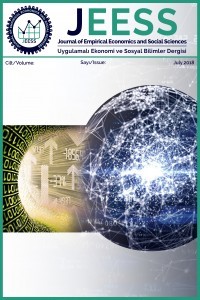EVALUATING THE COST-BENEFIT OF A WASTE HEAT RECOVERY ENERGY SYSTEM WITH EXERGOECONOMICS
EVALUATING THE COST-BENEFIT OF A WASTE HEAT RECOVERY ENERGY SYSTEM WITH EXERGOECONOMICS
Energy System, Waste Heat Recovery, Energy Economics, Exergy Exergoeconomics,
___
- Bejan, A., Moran, M. J., & Tsatsaronis, G. (1996). Thermal design and optimization. Wiley. com.Cengel, Y. A., & Boles, M. A. (2015). Thermodynamics : an engineering approach. New York: McGraw Hill.Current price development oil and gas - DNV GL. (n.d.). Retrieved July 17, 2019, from https://www.dnvgl.com/maritime/lng/current-price-development-oil-and-gas.htmlFergani, Z., Touil, D., & Morosuk, T. (2016). Multi-criteria exergy based optimization of an Organic Rankine Cycle for waste heat recovery in the cement industry. Energy Conversion and Management, 112, 81–90. https://doi.org/https://doi.org/10.1016/j.enconman.2015.12.083He, S., Chang, H., Zhang, X., Shu, S., & Duan, C. (2015). Working fluid selection for an Organic Rankine Cycle utilizing high and low temperature energy of an LNG engine. Applied Thermal Engineering, 90, 579–589. https://doi.org/10.1016/J.APPLTHERMALENG.2015.07.039Kalikatzarakis, M., & Frangopoulos, C. A. (2015). Multi-criteria selection and thermo-economic optimization of Organic Rankine Cycle system for a marine application. International Journal of Thermodynamics, 18(2), 133–141.Koroglu, T., & Sogut, O. S. (2017). Advanced Exergoeconomic Analysis of Organic Rankine Cycle Waste Heat Recovery System of a Marine Power Plant. International Journal of Thermodynamics, 20(3), 140–151. https://doi.org/10.5541/eoguijt.336700Koroglu, Turgay. (2018). Developing Criteria For Advanced Exergoeconomic Performance Analysis of the Thermal Systems. Istanbul Technical University, Istanbul, Turkey.Mahmoudi, A., Fazli, M., & Morad, M. R. (2018). A recent review of waste heat recovery by Organic Rankine Cycle. Applied Thermal Engineering, 143, 660–675. https://doi.org/https://doi.org/10.1016/j.applthermaleng.2018.07.136MAN Energy Solutions SE. (2019). MAN 51/60DF Project Guide-Marine Four-stroke dual fuel engine compliant with IMO Tier III. Retrieved from www.man-es.comMondejar, M. E., Andreasen, J. G., Pierobon, L., Larsen, U., Thern, M., & Haglind, F. (2018). A review of the use of organic Rankine cycle power systems for maritime applications. Renewable and Sustainable Energy Reviews, 91, 126–151. https://doi.org/https://doi.org/10.1016/j.rser.2018.03.074Quoilin, S., Van Den Broek, M., Declaye, S., Dewallef, P., & Lemort, V. (2013). Techno-economic survey of Organic Rankine Cycle (ORC) systems. Renewable and Sustainable Energy Reviews, 22, 168–186.Schuster, A., Karellas, S., Kakaras, E., & Spliethoff, H. (2009). Energetic and economic investigation of Organic Rankine Cycle applications. Applied Thermal Engineering, 29(8), 1809–1817. https://doi.org/https://doi.org/10.1016/j.applthermaleng.2008.08.016Shi, L., Shu, G., Tian, H., & Deng, S. (2018). A review of modified Organic Rankine cycles (ORCs) for internal combustion engine waste heat recovery (ICE-WHR). Renewable and Sustainable Energy Reviews, 92, 95–110. https://doi.org/https://doi.org/10.1016/j.rser.2018.04.023Shu, G., Liang, Y., Wei, H., Tian, H., Zhao, J., & Liu, L. (2013). A review of waste heat recovery on two-stroke IC engine aboard ships. Renewable and Sustainable Energy Reviews, 19, 385–401. https://doi.org/http://dx.doi.org/10.1016/j.rser.2012.11.034Shu, G., Liu, P., Tian, H., Wang, X., & Jing, D. (2017). Operational profile based thermal-economic analysis on an Organic Rankine cycle using for harvesting marine engine’s exhaust waste heat. Energy Conversion and Management, 146, 107–123. https://doi.org/https://doi.org/10.1016/j.enconman.2017.04.099Song, J., Li, Y., Gu, C., & Zhang, L. (2014). Thermodynamic analysis and performance optimization of an ORC (Organic Rankine Cycle) system for multi-strand waste heat sources in petroleum refining industry. Energy, 71, 673–680. https://doi.org/https://doi.org/10.1016/j.energy.2014.05.014Song, J., Song, Y., & Gu, C. (2015). Thermodynamic analysis and performance optimization of an Organic Rankine Cycle (ORC) waste heat recovery system for marine diesel engines. Energy, 82, 976–985. https://doi.org/http://dx.doi.org/10.1016/j.energy.2015.01.108Sprouse III, C., & Depcik, C. (2013). Review of organic Rankine cycles for internal combustion engine exhaust waste heat recovery. Applied Thermal Engineering, 51(1–2), 711–722. https://doi.org/http://dx.doi.org/10.1016/j.applthermaleng.2012.10.017Tsatsaronis, G. (1996). Exergoeconomics: Is it only a new name? Chemical Engineering & Technology, 19(2), 163–169. https://doi.org/doi:10.1002/ceat.270190210Wang, X.-Q., Li, X.-P., Li, Y.-R., & Wu, C.-M. (2015). Payback period estimation and parameter optimization of subcritical organic Rankine cycle system for waste heat recovery. Energy, 88, 734–745. https://doi.org/https://doi.org/10.1016/j.energy.2015.05.095
- ISSN: 2667-7210
- Başlangıç: 2018
- Yayıncı: Burak DARICI
Asef YELGHİ, Merve GÜRSOY, Aref YELGHİ
STUDY OF FACTORS THAT EFFECT AND INFLUENCE ON THE PERSONAL FINANCIAL MANAGEMENT OF THE YOUNG ADULT
Ye Ko Ko HTET, Sumas WONGSUNOPPARAT
EVALUATING THE COST-BENEFIT OF A WASTE HEAT RECOVERY ENERGY SYSTEM WITH EXERGOECONOMICS
STUDY OF FACTORS AFFECTING CONSUMERS’ PURCHASING BEHAVIOR VIA ONLINE NETWORKS IN BANGKOK
